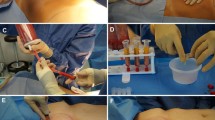Abstract
Introduction
Aesthetic breast area improvements for gynecomastia and gender dysphoria patients who seek a more masculine appearance have increased recently. We present our clinical experience in breast masculinization and a classification for these patients.
Methods and Materials
From July 2003 to May 2014, 68 patients seeking a more masculine thorax underwent surgery. They were divided into five groups depending on three factors: excess fatty tissue, breast tissue, and skin. A specific surgical treatment was assigned according to each group. The surgical treatments included thoracic liposuction, subcutaneous mastectomy, periareolar skin resection in one or two stages, and mastectomy with a nipple areola complex graft. The evaluation was performed 6 months after surgery to determine the degree of satisfaction and presence of complications.
Results
Surgery was performed on a total of 68 patients, 45 male and 22 female, with ages ranging from 18 to 49 years, and an average age of 33 years. Liposuction alone was performed on five patients; subcutaneous mastectomy was performed on eight patients; subcutaneous mastectomy combined with liposuction was performed on 27 patients; periareolar skin resection was performed on 11 patients; and mastectomy with NAC free grafts was performed on 16 patients. The surgical procedure satisfied 94% of the patients, with very few complications.
Conclusions
All patients who wish to obtain a masculine breast shape should be treated with only one objective regardless patient’s gender: to obtain a masculine thorax. We recommend a simple mammary gland classification for determining the best surgical treatment for these patients
Level of Evidence V
This journal requires that authors assign a level of evidence to each article. For a full description of these Evidence-Based Medicine ratings, please refer to the Table of Contents or the online Instructions to Authors www.springer.com/00266.











Similar content being viewed by others
References
Fruhstorfer BH, Malata CM (2003) A systematic approach to the surgical treatment of gynaecomastia. Br J Plast Surg 56(3):237–246
Webster JP (1946) Mastectomy for gynecomastia through a semicircular intra-areolar incision. Ann Surg 124(3):557–5753
Morselli PG (1996) “Pull-through”: a new technique for breast reduction in gynecomastia. Plast Reconstr Surg 97(2):450–454
ASAPS statistics. Cosmetic Surgery National Data Bank. Statistics 2012
Nydick M, Bustos J, Dale JH Jr, Rawson RW (1961) Gynecomastia in adolescent boys. JAMA 178(4):449–454
Hage JJ, Kesteren PJM (1995) Chest-wall contouring in female-to-male transsexuals: basic considerations and review of the literature. Plast Reconstr Surg 96:386
Carlson HE (1980) Gynecomastia. N Engl J Med 303(14):795–799
Pensler JM, Silverman BL, Sanghavi J et al (2000) Estrogen and progesterone receptors in gynecomastia. Plast Reconstr Surg 106(5):1011–1013
Bannayan GA, Hajdu SI (1972) Gynecomastia: clinicopathologic study of 351 cases. Am J Clin Pathol 57(4):431–437
Rohrich RJ, Ha RY, Kenkel JM, Adams WP Jr (2003) Classification and management of gynecomastia: defining the role of ultrasound-assisted liposuction. Plast Reconstr Surg 111(2):909–923 discussion 924–5
Lemaine V, Cayci C, Simmons PS, Petty P (2013) Gynecomastia in adolescent males. Semin Plast Surg. 27(1):56–61
Adekunle A, Malata CM (2012) Gynecomastia: evolving paradigm of management and comparison of techniques. Plast Reconstr Surg 129(2):366e–367e
Monstrey S, Selvaggi G, Ceulemans P, Monstrey S, Van Landuyt K, Bowman C, Blondeel P, Hamdi M, De Cuypere G (2008) Chest-wall contouring surgery in female-to-male transsexuals: a new algorithm. Plast Reconstr Surg 121(3):849–859
Simon BE, Hoffman S, Kahn S (1973) Classification and surgical correction of gynecomastia. Plast Reconstr Surg 51(1):48–52
Author information
Authors and Affiliations
Corresponding author
Ethics declarations
Conflict of Interest
The authors have no conflict of interest to declare in relation to the content of this article.
Rights and permissions
About this article
Cite this article
Cardenas-Camarena, L., Dorado, C., Guerrero, M.T. et al. Surgical Masculinization of the Breast: Clinical Classification and Surgical Procedures. Aesth Plast Surg 41, 507–516 (2017). https://doi.org/10.1007/s00266-016-0731-9
Received:
Accepted:
Published:
Issue Date:
DOI: https://doi.org/10.1007/s00266-016-0731-9




